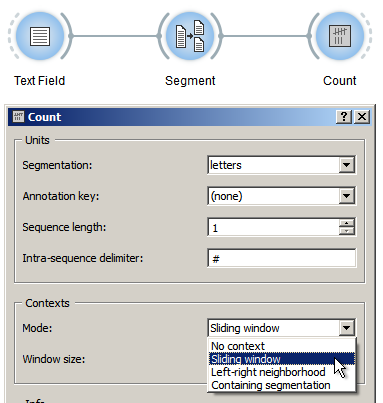Examine the evolution of unit frequency along the text¶
Goal¶
Examine how the frequency of segment types evolves from the beginning to the end of a segmentation.
Prerequisites¶
Some text has been imported in Orange Textable (see Cookbook: Text input) and it has been segmented in smaller units (see Cookbook: Segment text in smaller units).
Procedure¶

Figure 1: Examine the evolution of unit frequency with an instance of Count
- Create an instance of Count on the canvas.
- Drag and drop from the output connection (righthand side) of the widget instance that has been used to segment the text (e.g. Segment) to the Count widget instance’s input connection (lefthand side).
- Open the Count instance’s interface by double-clicking on its icon on the canvas.
- In the Units section, select the segmentation whose units will be counted.
- In the Context section, choose Mode: Sliding window.
- Set the Window size parameter to the desired value; with the minimum value of 1, frequency will be counted separately at every successive position in the segmentation, whereas a larger value n > 1 will have the effect that frequency will be counted in larger and partially overlapping spans (segments 1 to n, then 2 to n + 1, and so on), resulting in a smoother curve.
- Click the Compute button (or make sure the Compute automatically checkbox is selected).
- A table showing the results is then available at the output connection of the Count instance; to display or export it, see Cookbook: Table output.
Comment¶
- It is also possible to define units as segment pairs (bigrams), triples (trigrams), and so on, by increasing the Sequence length parameter in the Units section.
- If Sequence length is set to a value greater than 1, the string
appearing in the Intra-sequence delimiter field will be inserted between
the elements composing each n-gram in the column headers, which can
enhance their readability. The default is
#but you can change it by inserting the delimiter of your choice.
